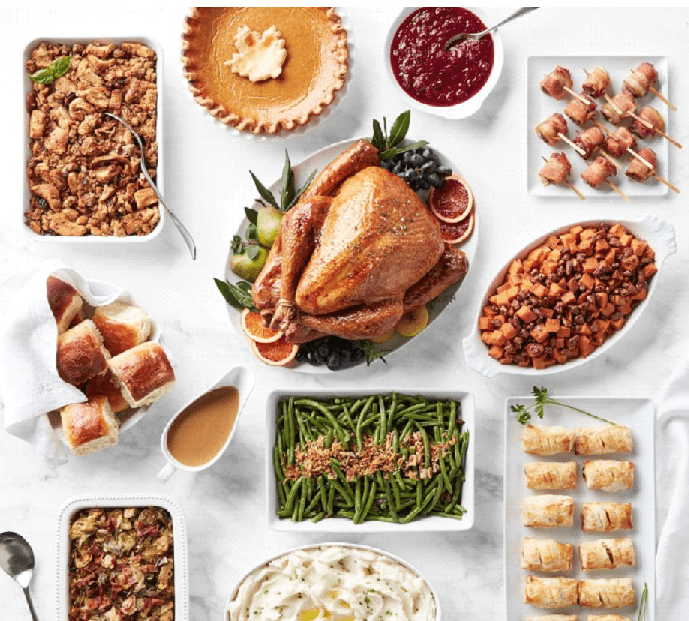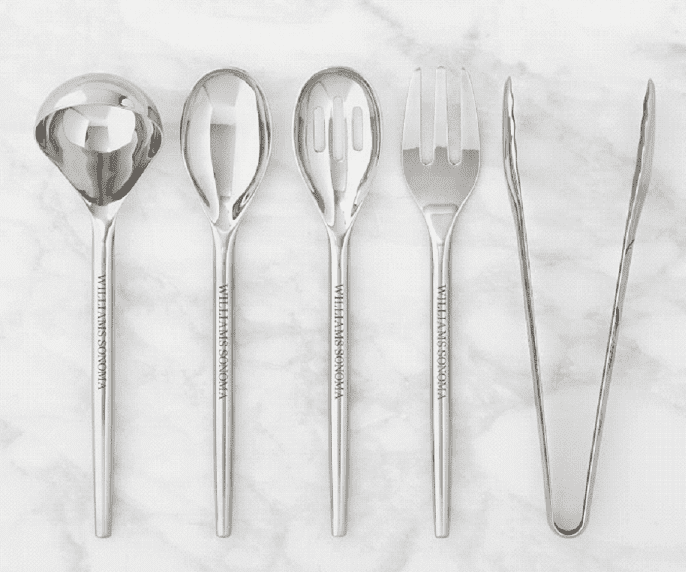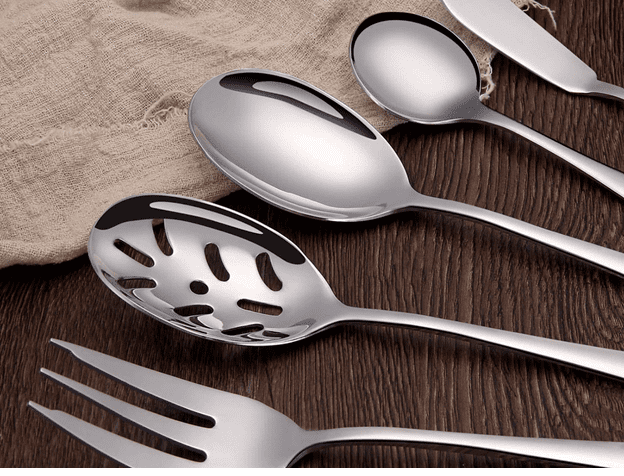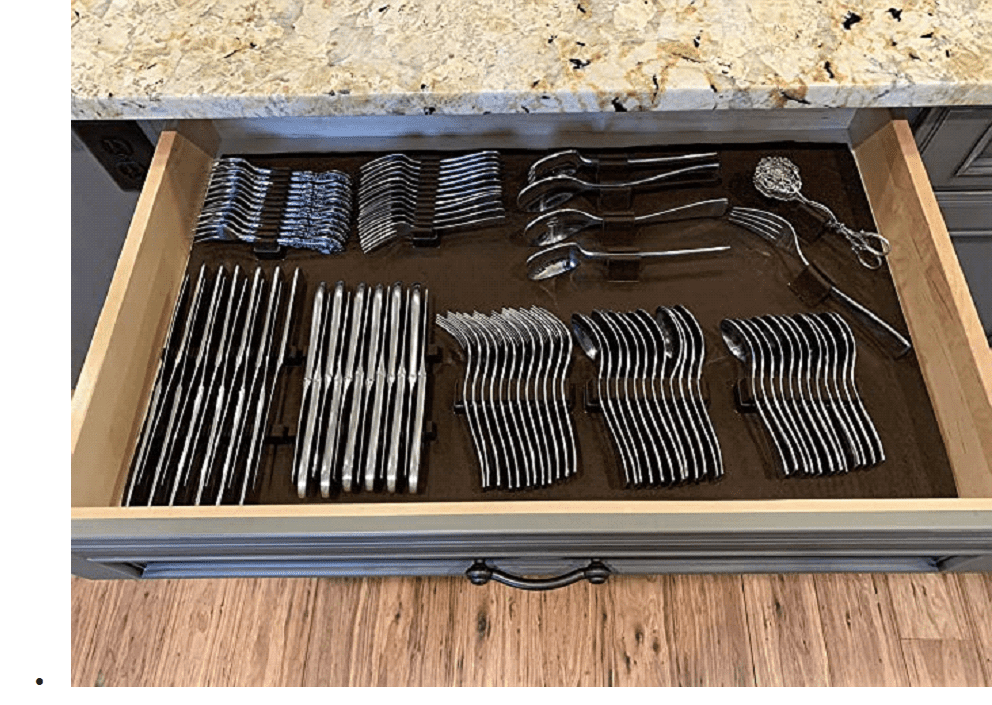
Organizing Serving Utensils
With the holidays approaching quickly, it makes for a great time to organize all your serving utensils. First, have the serving knives sharpened and declutter all the worn, stained, or serving pieces you have not used in the past few holidays; yes, you know which ones I am talking about, the ugly, out-of-style ones. Also, the gifted pieces you never liked need to go; no one will ever notice or care if they are not part of the party table!
A serving utensil transfers food from a large platter, tray, or bowl onto a single serving dish, like a plate or bowl for eating. These utensils come in various forms designed to cut, spread, scoop, and so on. There is an extensive collection of serving utensils and a specialty utensil for nearly every kind of food. However, servers, such as tongs, large, long-handled spoons, and forks, are universal and serve most foods. Examples of serving utensils are butter knives and salad servers. When organizing your serving utensils, gather them from the kitchen, dining room, and any storage area that houses your entertainment items, as it’s common for these items to reside throughout the home when they’re used in various locations. After collecting them, form two separate piles when you have both formal and casual serving pieces. Divide servers by type, such as spoon or fork servers. The following information discusses ways to approach downsizing and organizing every kind of server.

Serving Spoons
When organizing serving spoons, first separate them according to handle length and bowl size. Consider adding cooking spoons and ladles with one-piece construction, as they’re attractive enough to transfer to the table. Such division allows you to see the differences among your serving spoons, which will help downsize inventories accurately. Visualize yourself pulling spoon servers out to use for guests and focus on the pieces that you tend not to use; permanently remove them from your collection. Next, cut down an overstock of a certain spoon with a distinct handle length and bowl size by eliminating the hard-to-clean silver-plated spoons and those that don’t match other servers or your flatware pattern. Eliminate the spoon servers that don’t perform well, such as ladles that continue to dispense after pouring syrup, gravy, and soups. It may be worth your while to test some to determine which ones are best; you may have a well-designed, drip-free spoon and not even know it. The handle lengths on your serving spoons coincide with the serving platters and bowls. It’s important to skim through your platters and serving bowls to know precisely which serving spoons are necessary to keep on hand. Generally, it’s best to keep two serving utensils, each in size large, medium, and small. In addition, two pierced spoons for fruits and vegetables are also necessary.

Serving Forks and Tongs
First, start sorting your serving forks into three piles according to size: small, medium, and large. Remove all that is badly worn and never used. Notice whether there are any esoteric serving forks for which you cannot identify their intended use. Research those serving forks to find their purpose so you can receive more use from them or choose to eliminate them.
Small (Short-Handled) Forks
Smaller table serving forks suitable for side items, such as limes, lemons, olives, pickles, and the like, are helpful but unnecessary. A miniature tong can also do the job. When you prefer using small serving forks for these items, make sure they’re sharp enough to penetrate these foods. You only need to stock a few small serving forks. Appetizer forks are another story. You can use one or two six- to eight-piece sets of appetizer forks, depending upon the number of guests you entertain at any given time. Appetizers, cocktails, desserts, hors d’oeuvre, or seafood forks are generally interchangeable.
Medium Forks
Many medium-size serving forks were named for the food they were intended to serve long ago when times were more formal; however, they can usually be used to serve other types of foods. For example, a cold meat fork can serve lamb chops, waffles, or French toast. Medium-sized serving forks that serve multiple functions are good to stock in numbers.
Large (Long-Handled) Forks
There are a few important long-handled servers that you should keep one of each if you possess them. The popular two-pronged holding fork contained in carving sets is necessary to assist in the cutting of hams, roasts, and turkeys.
A large, curved fork for transferring heavier foods is also good to have. Long-handled banquet forks or cold meat forks are typically four-pronged and useful when entertaining buffet style with chafing pans. Keep a number that would accommodate your largest buffet-style event. Banquet forks used exclusively with chafers can be stored inside the chafers.
Tongs
There are basically two types of serving tongs: standard and small. The larger tongs are used to serve salads, meats, vegetables, and potatoes. The smaller tongs can serve appetizers, ice, pastries, and the like.
In many cases, tongs can easily be substituted with serving forks and flat servers. Therefore, you don’t need to have more than two large and small tongs on hand unless you have a serving preference for them. Select a single-drawer compartment to keep all the tongs together. Lay the tongs on their back to form a V. Then place all the serving tongs in a graduated pattern so that the smaller tongs fit inside

Serving Knives
Few knives are have serving potential because most of the cutting is done in the kitchen before serving foods on platters and in dishes. When you declutter, realize the number needed to keep for each type of serving knife. Stock one to two sets of carving knives often sold in cutting sets. Butter knives are suitable to store in pairs, especially when two butter trays need a long table. Keep no more than two all-purpose serving knives, especially when you have other specialty knife varieties. Cocktail knives and spreaders are necessary for serving condiments, spreads, and several appetizers. Therefore, house a quantity that can accommodate your largest cocktail party, which is commonly two sets.
Flat Servers
Begin organizing your flat servers by first sorting them by type. To downsize your inventories successfully, recognize the different uses each piece offers. For example, a pie server can serve molded salads, pizza slices, fish, or frozen desserts. A few well-constructed, multipurpose flat servers are needed in most homes—stock both multipurpose serrated and nonserrated flat servers. Uncommon flat servers, such as for sardines or asparagus, commonly receive limited use. The space they hog may not be justified when you can easily use a universal server in place. Finally, pack away any family heirloom servers or antiques for future generations, or sell those you don’t use.

Cheese Servers
The varieties and amounts of cheese you serve at a time will dictate the quantities and types of cheese tools you’ll need. To begin organizing your cheese tools, separate the serving tools that accompany the cheese boards from those only used in the kitchen. Standard cheese tools used exclusively in the kitchen are cheese grates, shavers, scrapers, curlers, scissors, grippers, and knives. Learning how to serve cheese properly will help you eliminate unnecessary tools. Since it’s courteous to cater to the many palates of guests, offering an array of soft, hard, mild, sharp, and strong cheeses will require that you maintain a diverse assortment of tools that can cut different textures of cheese. Cheese knives follow simple rules. Generally, skeleton knives with holes in the blade prevent soft cheeses from sticking to the edge. Narrow, rectangular blades are suitable for semisoft cheeses. Spreader knives are perfect for spreadable cheeses. Two-tine knives cut soft to medium-hard cheeses. Wide, rectangular cheese knives cut soft, crumbly cheeses like blue cheese. Tear-shaped, pointed knives are for hard cheese like Parmesan. Two-handled knives also cut hard cheeses in a seesaw fashion. Storing no more than two of each type of cheese knife can accommodate most occasions. A chef’s knife carrying case can also store cheese tools in a kitchen drawer next to other servers or on a cabinet shelf near the cheeseboards. Stackable containers can hold individual cheeseboards plus accompanying cheese tools. Use blade protectors for the cheese knives when they’re stored loosely in a container. These containers can reside on a shelf or in a drawer.
Dessert Servers
Gather all your dessert servers and sort them according to types, such as pie, cake, jelly, and ice cream. Keep sets together, such as wedding cake knives that pair with a flat server. Formal sets used on rare occasions can move out of the kitchen drawers and into a buffet, hutch, or china cabinet. To determine how many dessert servers you need to keep on hand, consider the largest gathering of guests you would ever entertain.

Drawer Liners for Serving Pieces
Drawer liners are a good investment because they protect the guts of your cabinets from spills and markings. Many materials, especially wood, are porous; many liquids, such as oils, can permeate your drawers and cause stains and lasting odor. Drawer liners also cushion and stabilize your serving pieces to prevent them from sliding all over the place from drawer movement and creating disorder or scratches. Many drawer liners are absorbent or drain, taking in moisture that otherwise can create water spots and tarnish serving pieces; these liners should be avoided. There are several drawer liners for the storage of serving pieces. The drawer liner material and personal preference are the main determinants for selecting a drawer liner. The following is a list of the different drawer liners often promoted for serving pieces, along with storage facts.
- CORK drawer liners come with an adhesive backing so they stay in place well. In addition, cork resists mold and mildew and provides a soft cushion for serving pieces.
- NONADHESIVE LATTICE or GRID-PATTERNED drawer liners have a breathable, open-weave design that provides drainage, so moisture/ water does not lie stagnant on top of it. These nonskid liners are commonly rubber, washable, and antimicrobial and keep contents from sliding around inside from drawer movement. However, they’re not recommended for lacquered or urethane-coated cabinet surfaces or silverware because rubber contains sulfur, which can damage them.
- PLASTIC is a common material used for many types of drawer liners. They protect the drawer and are washable. However, the plastic must be ribbed or textured, so it’s not slippery and will stabilize serving pieces.
- SILVER CLOTH is a cotton flannel material chemically treated with anti-tarnishing properties that are best used to line drawers for silver or silver-plated flatware and serving pieces. It’s designed to prevent tarnish and minimize polishing and also protects against dust and scratches. There are different grades of silver cloth, such as tarnish preventative that lasts decades or tarnish-resistant that requires replacement every few years. A silver cloth is commonly sold by the yard at fabric stores and various online websites. It’s easy to measure and cut with scissors.
Caring for Silver and Silver-Plated Serving Pieces in Storage Silver and silver-plated serving pieces should not contact stainless steel. When these metals touch, stain damage will occur on the silver. As previously mentioned, silver-plated and silver serving pieces should not contact rubber, which contains sulfur responsible for silver corrosion. Therefore, don’t use rubber-padded storage devices for your fine silver. Regular cleaning with soapy water helps reduce tarnish on silver and silver-plated servers caused by sulfur in the air. Ensure to properly clean and fully dry silver servers before returning them to storage, especially when they contact sulfur-containing foods, such as eggs, onions, and spinach, which can cause tarnish. Also, keep silver-based servers away from other elements that produce tarnish, such as wool, humidity, felt, latex gloves, carpet padding, and body oils. Silver is a soft metal and can scratch easily, so separate silver servers by placing them in individual compartments to prevent them from rattling against one another.
